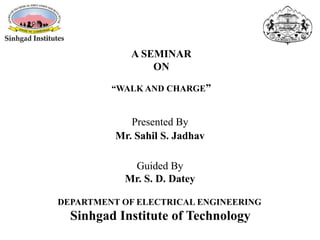
seminar_ppt_walk_and_charge[1].pptx
- 1. Presented By Mr. Sahil S. Jadhav A SEMINAR ON “WALK AND CHARGE” Guided By Mr. S. D. Datey DEPARTMENT OF ELECTRICAL ENGINEERING Sinhgad Institute of Technology
- 2. 1. Introduction 2. Working principle 3. Operations 4. Methodology 5. Advantages / Disadvantages 6. Future scope 7. Conclusion 8. References Contents
- 3. Introduction • Mobile phones are used widely in our everyday lives giving us the freedom to communicate anywhere and at anytime. • Equipped with various facilities, it is available to people of all classes. The affordable price range and the easy application make it a pleasure to use. • Besides communication, they also have various other services programmed in them. • The latest mobile phones are incorporated with features like MP3 players, high resolution camera, high sound quality, 3G technology and the list goes on. • The mobile phones have become a hit among all classes of people from kids to teenagers to adults allowing them to enjoy a tech-savvy lifestyle.
- 4. These chargers come in five basic varieties: Wall chargers, Car chargers, Desktop chargers, Emergency chargers and Green chargers. CONT..
- 5. WORKING PRINCIPLE: This device has to be worn below the knee cap on one leg and a light string is attached to the other leg. The strides taken help in pulling and retracting the string, which is further attached to a dynamo that generates about 3.5 Watts; enough to charge low- powered devices such as our mobile phones. This device captures the energy by connecting an electrical generator to leg movements. When the person extends the gap between the legs, power is generated by a gear that turns and spins the generator. The flexion of the leg turns off the gear so as not to discomfort the person.
- 6. Mechanical to Electrical Energy Storing the electrical energy Using this energy to charge Mobile Phones OPERATION: The mechanism involves three basic stages: •Conversion of mechanical to electrical energy •Storing the electrical energy •Using this energy to charge mobile phones Conversion of mechanical to electrical energy
- 7. Using this energy to charge mobile phones: Most mobile phone chargers are not really chargers, only adapters that provide a power source for the charging circuitry which is almost always contained within the mobile phone. They are notably diverse, having a wide variety of DC connector-styles and voltages, most of which are not compatible with other manufacturers' phones or even different models of phones from a single manufacturer.
- 8. METHODOLOGY • In this Electrical Power Generation Using Foot Steps Project, we are generating electrical power as non-conventional method by simply walking or running on the footstep. For this purpose, piezoelectric sensor is used in order to measure force, pressure and acceleration by its change into electric signals. • A piezoelectric sensor is an electric device which is used to measure acceleration, pressure, or force to convert them to an electric signal. These sensors are mainly used for process control, quality assurance, research and development in various industries. • The applications of this sensor involve, aerospace, medical, instrumentation, and as a pressure sensor it is used in the touch pad of mobile phones. In the automotive industry, these sensors are used to monitor ignition when developing internal burning engines. • Two technologies have been tested so far to convert energy used in walking into electrical power. 1: Uses of piezoelectric material. 2: Placing small electro- mechanical devices, such as a dynamo. The mechanism involves three basic stages: 1 Conversion of mechanical to electrical energy 2 Storing the electrical energy 3 Using this energy to charge mobile phone
- 9. MERITS AND DEMERITS 1. MERITS • Power generation is simply walking on the step. • Power also generated by running or exercising on the step. • No need fuel input. • This is a Non-conventional system. • Battery is used to store the generated power. 1. DEMERITS • Only applicable for the particular place. • Mechanical moving parts is high . • Initial cost of this arrangement is high. • Care should be taken for batteries.
- 10. ADVANTAGES and FUTURE PROSPECTIVES: • Increasing the effectiveness of mobiles in rural India by providing a portable means of charging of mobiles, torches, radios. • Helping military personnel charge their GPS devices and other low-power electronic gadgets while on the move. • Providing an alternate means to wall-based charging for MP3 players, mobiles, etc in cities, thereby, helping today’s fast generation to move faster without mobile battery problems. • India has signed the Kyoto Protocol – an acknowledgement that we share the concern of global warming, which also expresses our commitment to slow down climate change. Walk-N-Charge would just add to the efforts put in by India in various innovative ways. • Charging your cell phone might soon be as simple as taking a walk around the block.
- 11. 6. Conclusion Even if 0.1% of the Indian population uses this device, it can generate 1500 kW/h of energy and can help reduce carbon emission by 2.25 tones per day. Thus, Walk-N-Charge promises us a source of energy that is not only clean, portable and inexpensive, but also charges our mobile while you get charged up!
- 12. 7. References 1. J. A. Paradiso and T. Starner, “Energy scavenging for mobile and wireless electronics,” Pervasive Comput. IEEE, vol. 4, no. 1, pp. 18–27, 2005 2. P. D. Mitcheson, E. M. Yeatman, G. K. Rao, A. S. Holmes, and T. C. Green, “Energy harvesting from human and machine motion for wireless electronic devices,” Proc. IEEE, vol. 96, no. 9, pp. 1457–1486, 2008. 3. M. Jain, U. Tiwari, and M. Gupta, “Mobile charger via walk,” in Multimedia, Signal Processing and Communication Technologies (IMPACT), 2011 International Conference on, 2011, pp. 149–152.
- 13. THANK YOU